The global porous plastic tubes market is valued at USD 81.6 million in 2025 and is slated to reach USD 127.9 million by 2035, recording an absolute increase of USD 46.3 million over the forecast period. Key opportunities in the porous plastic tubes market are emerging from the increasing need for controlled fluid and gas flow components across precision-driven environments. A major opportunity lies in the medical and life sciences sector, where porous tubes are being integrated into drug delivery devices, respiratory support systems, and diagnostic instruments that require consistent flow regulation and biocompatible materials.
Growing investment in laboratory automation is also expanding the use of porous tubes in sample preparation, reagent dosing, and microfluidic platforms where reproducibility and contamination control are critical. Industrial processing applications present another opportunity, particularly in chemical handling, fuel cell humidification systems, and pneumatic equipment, where porous tubes offer predictable permeability and long-term durability. The water and environmental treatment segment is expected to generate sustained demand for porous aeration and gas diffusion tubes, supporting applications such as aquaculture oxygenation, wastewater treatment aeration, and groundwater remediation. Additionally, manufacturers have the opportunity to differentiate through customized porosity grades, advanced polymer blends, and integration-ready modular designs that align with equipment OEM requirements. As end users move toward compact, high-efficiency treatment and processing systems, demand for engineered porous tube solutions with repeatable and tunable performance characteristics is anticipated to strengthen.

Consumer behavior in the porous plastic tubes market reflects broader industrial trends toward high-performance, chemical-resistant systems that provide both separation efficiency benefits and extended operational life improvements. The porous plastic tubes market benefits from the growing popularity of standard PE type applications, which are recognized for their advanced porosity integration and user-friendly approach to fluid management systems. The versatility of porous plastic tubes as both standalone filtration components and integrated separation elements supports steady demand across multiple industrial applications and price segments.
Regional adoption patterns vary significantly, with Asian markets showing strong preference for PE type implementations, while European markets demonstrate increasing adoption of specialized PP solutions alongside conventional laboratory filtration systems. The industrial landscape continues to evolve with sophisticated and feature-rich porous plastic products gaining traction in mainstream laboratory brands, reflecting manufacturer willingness to invest in proven filtration technology improvements and application-oriented features.
The competitive environment features established filtration component companies alongside specialized porous plastic providers that focus on unique material capabilities and advanced processing methods. Manufacturing efficiency and product development optimization remain critical factors for market participants, particularly as raw material costs and regulatory compliance continue to fluctuate. Distribution strategies increasingly emphasize multi-channel approaches that combine traditional laboratory supply chains with direct manufacturer partnerships through technology licensing agreements and system integration contracts.
Market consolidation trends indicate that larger filtration manufacturers are acquiring specialty porous plastic companies to diversify their product portfolios and access specialized polymer processing segments. Original equipment integration has gained momentum as laboratory equipment companies seek to differentiate their offerings while maintaining competitive cost structures. The emergence of specialized PTFE variants, including medical-grade and automotive-specific options, reflects changing industrial priorities and creates new market opportunities for innovative tube system developers. Manufacturing automation and quality control improvements enable consistent product scaling while maintaining traditional permeability characteristics that laboratory operators expect from established filtration materials.
Between 2025 and 2030, the porous plastic tubes market is projected to expand from USD 81.6 million to USD 102.1 million, resulting in a value increase of USD 20.5 million, which represents 44.3% of the total forecast growth for the decade. This phase of development will be shaped by increasing adoption of PE type systems, rising demand for scientific and laboratory solutions, and growing focus on separation efficiency features with enhanced permeability characteristics. Filtration manufacturers are expanding their processing capabilities to address the growing demand for specialized porous plastic implementations, advanced porosity options, and application-specific offerings across product segments.
| Metric | Value |
|---|---|
| Estimated Value (2025E) | USD 81.6 million |
| Forecast Value (2035F) | USD 127.9 million |
| Forecast CAGR (2025-2035) | 4.60% |
From 2030 to 2035, the porous plastic tubes market is forecast to grow from USD 102.1 million to USD 127.9 million, adding another USD 25.8 million, which constitutes 55.7% of the overall ten-year expansion. This period is expected to be characterized by the expansion of environmental treatment systems, the integration of innovative porous plastic solutions, and the development of specialized tube implementations with enhanced separation profiles and extended performance capabilities. The growing adoption of advanced formulations will drive demand for porous plastic tubes with superior chemical resistance characteristics and compatibility with modern filtration technologies across laboratory operations.
Between 2020 and 2025, the porous plastic tubes market experienced steady growth, driven by increasing demand for standard PE type systems and growing recognition of porous plastic components as essential elements for modern separation programs across laboratory and environmental applications. The porous plastic tubes market developed as filtration manufacturers recognized the potential for porous plastic solutions to provide both separation efficiency benefits and operational advantages while enabling streamlined processing protocols. Technological advancement in polymer chemistry and application-based development began focusing the critical importance of maintaining tube performance and user acceptance in diverse filtration environments.
Market expansion is being supported by the increasing global demand for advanced filtration separation systems and the corresponding need for porous plastic tube technologies that can provide superior permeability benefits and separation efficiency advantages while enabling enhanced fluid processing and extended compatibility across various laboratory and environmental treatment applications. Modern laboratory operators and industrial specialists are increasingly focused on implementing proven tube technologies that can deliver effective flow control, minimize traditional filtration dependency, and provide consistent performance throughout complex separation configurations and diverse chemical environments. Porous plastic tubes' proven ability to deliver exceptional filtration efficacy against traditional alternatives, enable advanced system integration, and support modern separation protocols makes them an essential component for contemporary laboratory and industrial processing operations.
The growing focus on separation efficiency and processing optimization is driving demand for porous plastic tubes that can support large-scale filtration requirements, improve separation outcomes, and enable advanced processing systems. User preference for components that combine effective chemical resistance with proven permeability and processing benefits is creating opportunities for innovative porous plastic implementations. The rising influence of laboratory automation trends and filtration performance awareness is also contributing to increased demand for porous plastic tubes that can provide advanced features, seamless system integration, and reliable performance across extended operational periods.
The porous plastic tubes market is poised for steady growth and technological advancement. As filtration manufacturers across North America, Europe, Asia-Pacific, and emerging markets seek systems that deliver exceptional separation quality, advanced permeability capabilities, and reliable performance options, porous plastic tube solutions are gaining prominence not just as filtration components but as strategic enablers of separation technologies and advanced processing functionality.
Rising PE type adoption in Asia-Pacific and expanding scientific laboratory initiatives globally amplify demand, while manufacturers are leveraging innovations in polymer engineering, advanced material integration, and permeability management technologies.
Pathways like environmental treatment implementations, medical-grade platforms, and specialized automotive solutions promise strong margin uplift, especially in premium component segments. Geographic expansion and product diversification will capture volume, particularly where local filtration preferences and advanced technology adoption are critical. Regulatory support around filtration standards, permeability protocols, and laboratory safety requirements give structural support.
The porous plastic tubes market is segmented by type, application, end user, pore size, tube diameter, wall thickness, distribution channel, price range, and region. By type, the porous plastic tubes market is divided into PE type, PP type, PTFE type, and other categories. By application, it covers scientific & lab use, environmental & water treatment, automotive, medical & healthcare, and other segments. By end user, it encompasses research laboratories, environmental companies, automotive manufacturers, and healthcare facilities. By pore size, the porous plastic tubes market includes 0.1-1 micron, 1-10 micron, 10-50 micron, and above 50 micron. By tube diameter, the porous plastic tubes market is categorized into 5-10mm, 11-20mm, 21-30mm, and above 30mm categories. By wall thickness, the porous plastic tubes market is divided into thin wall (below 2mm), medium wall (2-5mm), and thick wall (above 5mm). By distribution channel, the market includes direct sales, distributors, and online channels. By price range, the porous plastic tubes market covers premium, mid-range, and economy. Regionally, the porous plastic tubes market is divided into North America, Europe, East Asia, South Asia & Pacific, Latin America, and the Middle East & Africa.

The PE type segment is projected to account for 42.3% of the porous plastic tubes market in 2025, reaffirming its position as the leading type category. Filtration manufacturers and system integrators increasingly utilize PE type implementations for their superior chemical compatibility when operating across diverse separation platforms, excellent permeability properties, and widespread acceptance in applications ranging from basic laboratory filtration to premium environmental operations. PE-type technology's established processing methods and proven separation capabilities directly address the manufacturer's requirements for dependable filtration solutions in complex processing environments.
This type segment forms the foundation of modern filtration adoption patterns, as it represents the implementation with the greatest market penetration and established user acceptance across multiple application categories and price segments. Manufacturer investments in PE standardization and system consistency continue to strengthen adoption among filtration producers and processing companies. With laboratories prioritizing separation efficiency and fluid processing, PE type implementations align with both functionality preferences and cost expectations, making them the central component of comprehensive filtration strategies.
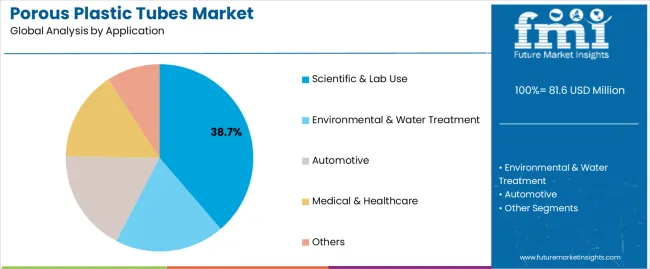
Scientific & lab use applications are projected to represent 38.7% of porous plastic tubes demand in 2025, underscoring their critical role as the primary application channel for separation processing across research facilities, laboratory operations, and analytical applications. Laboratory operators prefer porous plastic tubes for scientific use for their exceptional permeability characteristics, scalable processing options, and ability to enhance separation precision while ensuring consistent filtration quality throughout diverse research platforms and analytical operations. Positioned as essential separation components for modern laboratory production, porous plastic tube solutions offer both technological advantages and processing efficiency benefits.
The segment is supported by continuous innovation in laboratory filtration technologies and the growing availability of specialized implementations that enable diverse research requirements with enhanced separation uniformity and extended operational capabilities. Research facilities are investing in advanced technologies to support large-scale processing integration and method development. As separation precision trends become more prevalent and filtration performance awareness increases, scientific & lab use applications will continue to represent a major implementation market while supporting advanced research utilization and technology integration strategies.
The porous plastic tubes market is advancing steadily due to increasing demand for advanced filtration separation systems and growing adoption of porous plastic tube technologies that provide superior permeability characteristics and separation efficiency benefits while enabling enhanced fluid processing across diverse laboratory and environmental treatment applications. The porous plastic tubes market faces challenges, including complex polymer formulation requirements, evolving filtration regulations, and the need for specialized processing expertise and performance programs. Innovation in polymer chemistry and advanced processing systems continues to influence product development and market expansion patterns.
The growing adoption of advanced separation processing, sophisticated permeability management capabilities, and filtration performance awareness is enabling system developers to produce advanced porous plastic tube solutions with superior separation positioning, enhanced permeability profiles, and seamless integration functionalities. Advanced separation processing systems provide improved filtration outcomes while allowing more efficient processing workflows and reliable performance across various fluid applications and chemical environments. Developers are increasingly recognizing the competitive advantages of processing integration capabilities for market differentiation and separation positioning.
Modern porous plastic tube providers are incorporating advanced polymer technology, permeability protocol integration, and sophisticated processing solutions to enhance component appeal, enable intelligent separation features, and deliver value-added solutions to filtration customers. These technologies improve tube performance while enabling new market opportunities, including multi-layer systems, optimized surface treatments, and enhanced chemical resistance characteristics. Advanced permeability integration also allows developers to support comprehensive filtration tube technologies and market expansion beyond traditional separation approaches.

| Country | CAGR (2025-2035) |
|---|---|
| China | 6.2% |
| India | 5.8% |
| Germany | 5.3% |
| Brazil | 4.8% |
| United States (USA) | 4.4% |
| United Kingdom (UK) | 3.9% |
| Japan | 3.5% |
The porous plastic tubes market is experiencing steady growth globally, with China leading at a 6.2% CAGR through 2035, driven by expanding laboratory infrastructure capacity, growing filtration modernization programs, and significant investment in polymer tube development. India follows at 5.8%, supported by increasing research facility expansion, growing analytical technology integration patterns, and expanding scientific infrastructure. Germany shows growth at 5.3%, focusing filtration technology leadership and tube development. Brazil records 4.8%, focusing on expanding laboratory capabilities and filtration technology modernization. The USA exhibits 4.4% growth, focusing filtration innovation excellence and premium tube development. The UK demonstrates 3.9% growth, prioritizing advanced filtration technology development and separation processing trends. Japan shows 3.5% growth, supported by filtration technology initiatives and precision-focused production patterns.
The report covers an in-depth analysis of 40+ countries, top-performing countries are highlighted below.
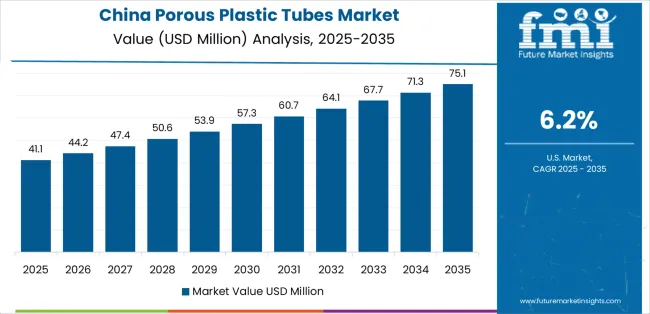
China is projected to exhibit robust growth with a CAGR of 6.2% through 2035, driven by expanding laboratory infrastructure capacity and rapidly growing filtration integration supported by government initiatives promoting scientific technology development. The country's strong position in research facility production and increasing investment in laboratory infrastructure are creating substantial demand for advanced porous plastic implementations. Major research institutions and technology companies are establishing comprehensive integration capabilities to serve both domestic filtration demand and expanding export markets.
India is expanding at a CAGR of 5.8%, supported by the country's growing research sector, expanding laboratory technology capacity, and increasing adoption of separation processing technologies. The country's initiatives promoting scientific modernization and growing analytical development awareness are driving requirements for technology-integrated filtration systems. International filtration providers and domestic laboratory companies are establishing extensive manufacturing and integration capabilities to address the growing demand for advanced separation solutions.
Germany is expanding at a CAGR of 5.3%, supported by the country's filtration technology heritage, strong focus on separation processing technology, and robust demand for advanced tube systems in laboratory and industrial applications. The nation's mature filtration sector and technology-focused operations are driving sophisticated porous plastic implementations throughout the processing industry. Leading manufacturers and filtration specialists are investing extensively in tube development and advanced integration technologies to serve both domestic and international markets.
Brazil is growing at a CAGR of 4.8%, driven by the country's expanding laboratory sector, growing scientific infrastructure programs, and increasing investment in filtration technology development. Brazil's large research market and commitment to scientific advancement are supporting demand for diverse porous plastic solutions across multiple application segments. Manufacturers are establishing comprehensive integration capabilities to serve the growing domestic market and expanding processing opportunities.
The USA is expanding at a CAGR of 4.4%, supported by the country's advanced filtration technology sector, strategic focus on separation processing solutions, and established laboratory capabilities. The USA's filtration innovation leadership and technology integration are driving demand for specialized porous plastic implementations in premium products, research applications, and advanced filtration systems. Manufacturers are investing in comprehensive technology development to serve both domestic specialty markets and international quality applications.
The UK is growing at a CAGR of 3.9%, driven by the country's focus on filtration technology advancement, focus on premium component innovation, and strong position in separation development. The UK's established filtration innovation capabilities and commitment to technology diversification are supporting investment in specialized porous plastic technologies throughout major processing regions. Industry leaders are establishing comprehensive technology integration systems to serve domestic premium component production and filtration applications.
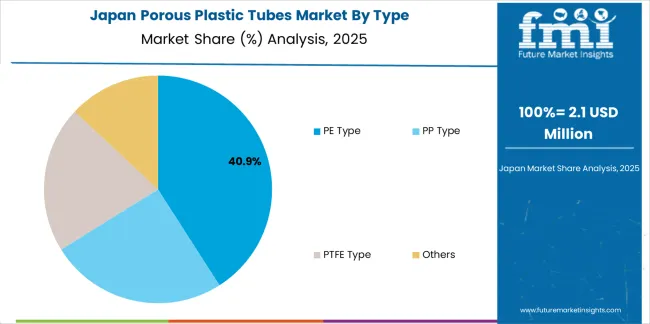
Japan is expanding at a CAGR of 3.5%, supported by the country's filtration excellence initiatives, growing precision technology sector, and strategic focus on advanced component development. Japan's advanced quality control capabilities and integrated filtration systems are driving demand for high-quality porous plastic platforms in premium products, filtration technology, and advanced separation applications. Leading manufacturers are investing in specialized capabilities to serve the stringent requirements of technology-focused filtration and premium component industries.
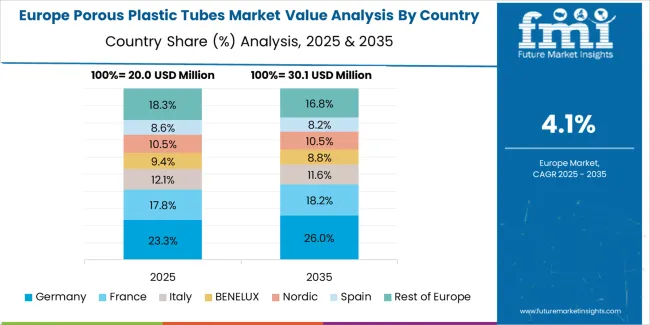
The porous plastic tubes market in Europe is projected to grow from USD 23.4 million in 2025 to USD 36.8 million by 2035, registering a CAGR of 4.6% over the forecast period. Germany is expected to maintain its leadership position with a 38.9% market share in 2025, growing to 40.2% by 2035, supported by its strong filtration engineering culture, sophisticated laboratory capabilities, and comprehensive filtration industry serving diverse porous plastic tube applications across Europe.
France follows with a 21.6% share in 2025, projected to reach 21.1% by 2035, driven by robust demand for laboratory filtration technologies in research applications, advanced scientific programs, and environmental treatment markets, combined with established laboratory infrastructure and technology integration expertise. The United Kingdom holds a 16.8% share in 2025, expected to reach 16.2% by 2035, supported by strong filtration technology sector and growing premium component activities. Italy commands a 12.7% share in 2025, projected to reach 12.3% by 2035, while Netherlands accounts for 6.4% in 2025, expected to reach 6.6% by 2035. Spain maintains a 3.6% share in 2025, growing to 3.6% by 2035. The Rest of Europe region, including Nordic countries, Eastern Europe, Belgium, Poland, and other nations, is anticipated to maintain momentum, with its collective share moving from 0.0% to 0.0% by 2035, attributed to increasing filtration modernization in Eastern Europe and growing technology penetration in Nordic countries implementing advanced separation processing programs.
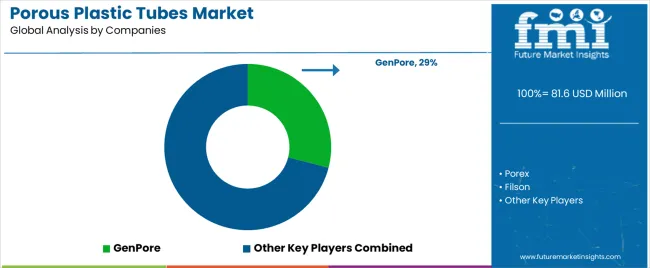
The porous plastic tubes market is characterized by competition among established filtration component companies, specialized porous plastic technology developers, and integrated separation solution providers. Companies are investing in polymer chemistry research, processing optimization, advanced tube system development, and comprehensive filtration portfolios to deliver consistent, high-quality, and application-specific porous plastic tube solutions. Innovation in advanced permeability integration, separation enhancement, and filtration compatibility improvement is central to strengthening market position and competitive advantage.
GenPore leads the porous plastic tubes market with a 29.0% market share, offering comprehensive filtration technology solutions, including quality tube platforms and advanced integration systems, with a focus on premium and laboratory applications. Porex provides specialized polymer capabilities with a focus on advanced porous plastic implementations and innovative filtration solutions. Filson delivers comprehensive separation services with a focus on integrated platforms and large-scale processing applications. Alfa Chemistry specializes in advanced tube technologies and specialized porous plastic implementations for premium applications.
| Item | Value |
|---|---|
| Quantitative Units | USD 81.6 million |
| Type | PE Type; PP Type; PTFE Type; Others |
| Application | Scientific & Lab Use; Environmental & Water Treatment; Automotive; Medical & Healthcare; Others |
| End User | Research Laboratories; Environmental Companies; Automotive Manufacturers; Healthcare Facilities |
| Pore Size | 0.1-1 Micron; 1-10 Micron; 10-50 Micron; Above 50 Micron |
| Tube Diameter | 5-10mm; 11-20mm; 21-30mm; Above 30mm |
| Wall Thickness | Thin Wall (Below 2mm); Medium Wall (2-5mm); Thick Wall (Above 5mm) |
| Distribution Channel | Direct Sales; Distributors; Online Channels |
| Price Segment | Premium; Mid-range; Economy |
| Regions Covered | North America; Europe; East Asia; South Asia & Pacific; Latin America; Middle East & Africa |
| Countries Covered | China; India; Germany; Brazil; United States; United Kingdom; Japan; France; and 40+ additional countries |
| Key Companies Profiled | GenPore; Porex; Filson; Alfa Chemistry |
| Additional Attributes | Dollar sales by type and application category; regional demand trends; competitive landscape; technological advancements in polymer engineering; advanced material development; permeability innovation; filtration integration protocols |
The global porous plastic tubes market is estimated to be valued at USD 81.6 million in 2025.
The market size for the porous plastic tubes market is projected to reach USD 127.9 million by 2035.
The porous plastic tubes market is expected to grow at a 4.6% CAGR between 2025 and 2035.
The key product types in porous plastic tubes market are pe type, pp type, ptfe type and others.
In terms of application, scientific & lab use segment to command 38.7% share in the porous plastic tubes market in 2025.






Full Research Suite comprises of:
Market outlook & trends analysis
Interviews & case studies
Strategic recommendations
Vendor profiles & capabilities analysis
5-year forecasts
8 regions and 60+ country-level data splits
Market segment data splits
12 months of continuous data updates
DELIVERED AS:
PDF EXCEL ONLINE
Porous Metal Sheet Market Analysis Size and Share Forecast Outlook 2025 to 2035
Porous Ceramic Market Growth - Trends, Analysis & Forecast by Product Type, End-use and Region through 2035
Macroporous Strong Acid Cation Exchange Resin Market Size and Share Forecast Outlook 2025 to 2035
Microporous Insulation Material Market Size and Share Forecast Outlook 2025 to 2035
Plastic Banding Market Size and Share Forecast Outlook 2025 to 2035
Plastic Tube Market Size and Share Forecast Outlook 2025 to 2035
Plastic Jar Packaging Market Forecast and Outlook 2025 to 2035
Plastic Cases Market Size and Share Forecast Outlook 2025 to 2035
Plastic Jar Industry Analysis in the United States Size and Share Forecast Outlook 2025 to 2035
Plastic Cutlery Market Forecast and Outlook 2025 to 2035
Plastic Vial Market Forecast and Outlook 2025 to 2035
Plastic Hot and Cold Pipe Market Forecast and Outlook 2025 to 2035
Plastic Retort Can Market Size and Share Forecast Outlook 2025 to 2035
Plastic Gears Market Size and Share Forecast Outlook 2025 to 2035
Plastic Additive Market Size and Share Forecast Outlook 2025 to 2035
Plastic Market Size and Share Forecast Outlook 2025 to 2035
Plastic Vials and Ampoules Market Size and Share Forecast Outlook 2025 to 2035
Plastic Healthcare Packaging Market Size and Share Forecast Outlook 2025 to 2035
Plastic Bottle Industry Analysis in Malaysia Size and Share Forecast Outlook 2025 to 2035
Plastic Drum Industry Analysis in Malaysia Size and Share Forecast Outlook 2025 to 2035

Thank you!
You will receive an email from our Business Development Manager. Please be sure to check your SPAM/JUNK folder too.
Chat With
MaRIA